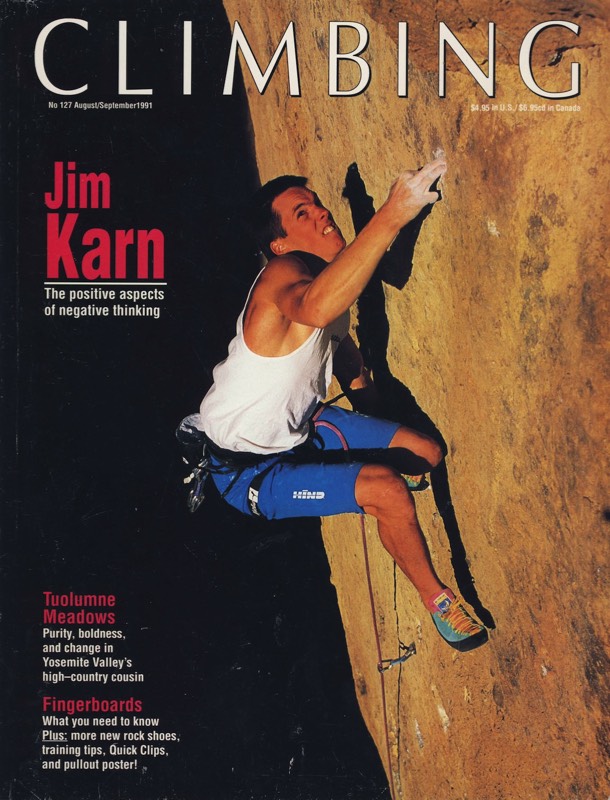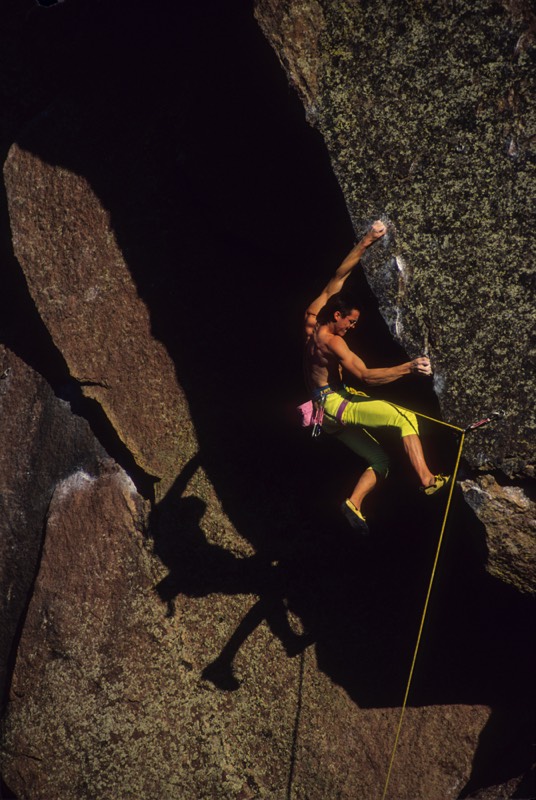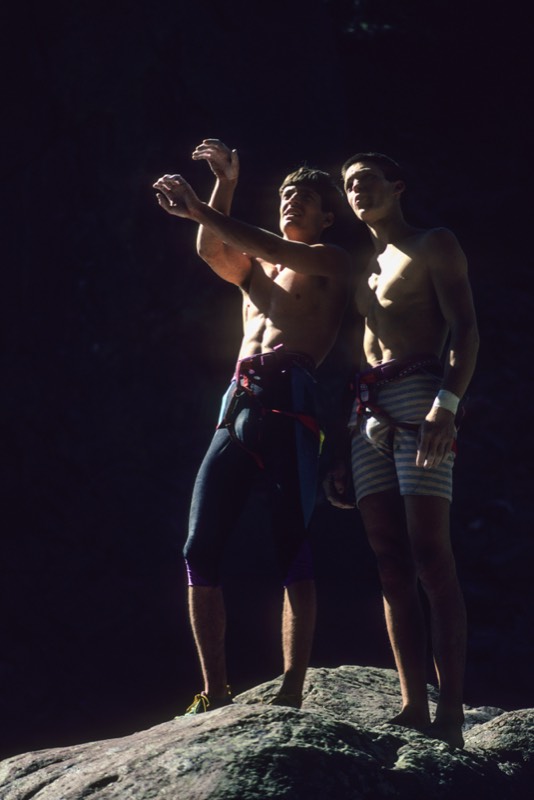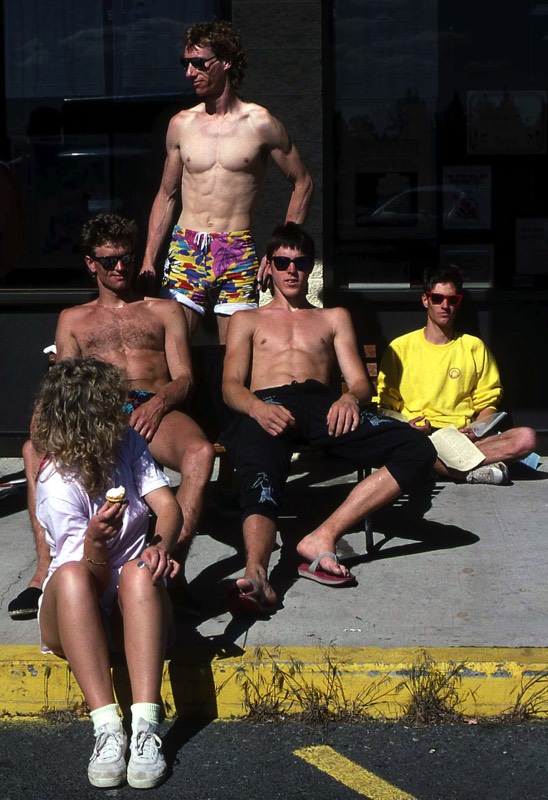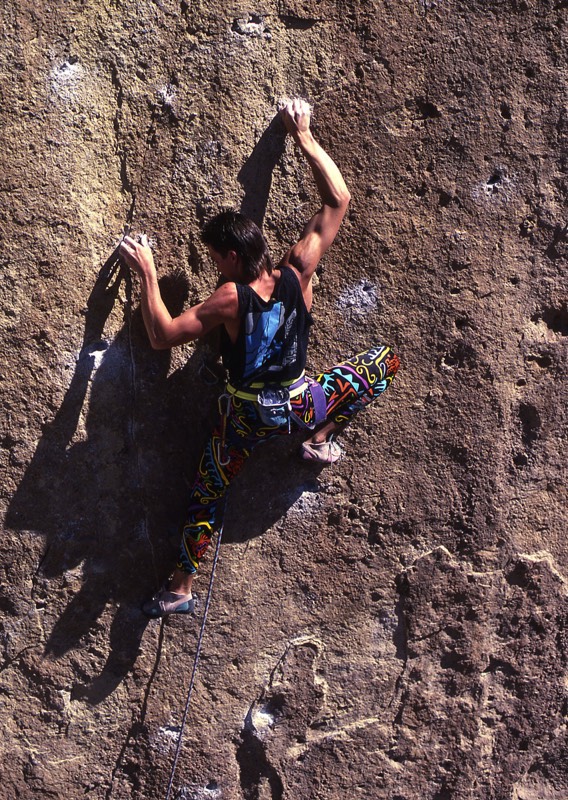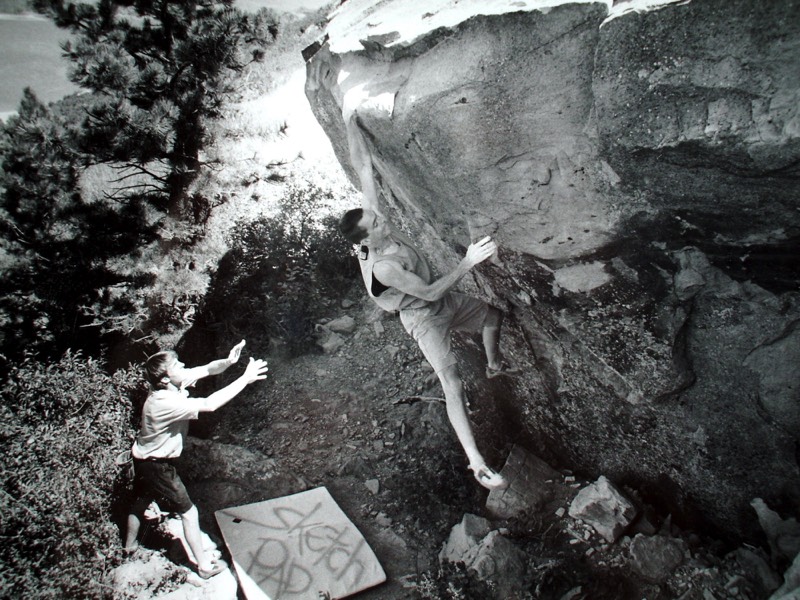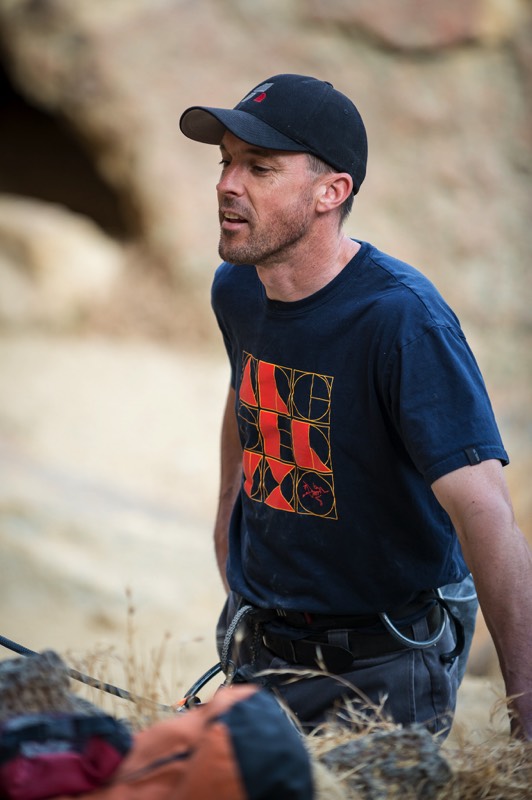Jim Karn - What Happened to One of North America's Best Climbers?
During the late 80s and early 90s, no one dominated the North American climbing scene as convincingly as Jim Karn. Not only did he have an unprecedented number of 5.14 ascents, but he also successfully competed and podiumed on the World Cup climbing circuit in Europe. And then suddenly, during what many felt were his peak years, he seemingly disappeared from the scene.
Since then, very little has been written about this incredibly talented climber and his significant impact on the North American climbing scene.
In this interview he discusses how he got into climbing, his rise to the top of the North American climbing scene, his success in Europe and why he suddenly dropped out of the sport.
You were born in Ohio – not necessarily the centre of North American rock climbing. How did you get into the sport?
Jim: As a kid I was really into sports and I read a lot. My mom used to take me to the library once a week or so and I worked my way through everything in the sports section. There were a few books about climbing that fascinated me. As I got older, I became disillusioned with team sports. I saw a lot of bad sportsmanship, nepotism and pettiness in little league baseball and football. Climbing seemed like the ideal sport for me, no teams, no politics and no bullshit (or so I thought at the time). So I saved up for a chunk of laid rope and a few carabiners, found some dried up waterfalls and started climbing. Soon after, I found Clifton Gorge and met some local climbers who took me in. They were absolutely incredible people and nothing could repay the kindness, wisdom and generosity they showed me. Words are insufficient to express the gratitude I have for those guys.
Jim Karn on the cover of the 1991 August/September issue of Climbing. The issue also had an article about Karn that was incredibly influential on an emerging generation of climbers.
Many of the readers may not remember that the US climbing scene initially had a hard time accepting sport climbing and comps. Why did you gravitate to these aspects of the sport rather than trad climbing?
Jim: When I started climbing, there was no distinction between sport and trad climbing. I learned to climb placing gear. I did plenty of the kind of climbing in which the difficulty lies in non-athletic aspects like danger, route-finding, gear placements, remoteness, etc., but the part of climbing that always held the most appeal for me was pure, gymnastic difficulty. I wanted to climb the hardest routes. I didn’t care if they were done ground-up on gear or bolted on rappel.
Jim Karn circa 1989
Photo courtesy of Beth Wald.
You were one of the first (maybe the first?) North Americans to go over to Europe and compete in UIAA (now the IFSC) World Cup events. What the heck were you thinking?
Jim: At that time, the best climbers in the world were in Europe. I mean best in the gymnastic sense; I’m not making a comparison with climbers from other arenas. I wanted to improve, and it was obvious to me that I should go where the best climbers were.
You were also the first North American to win a World Cup - La Riba in Spain in 1988. Did you think you would win this comp and did you at the time realize the significance of this accomplishment?
Jim: I didn’t think I would make it through two rounds much less win. The event was several days long, not just a weekend like later World Cups. At first, I was barely making it through the rounds, but as the days went on, I think people got tired or lost focus. I kept flailing away and somehow qualified for the final. I didn’t deserve to win. Marc LeMenestrel mistook the last quick draw for the anchor and stopped. He was a vastly better climber than me and made a simple mistake which handed me the win.
"This is at the Sun Spot in Terrebonne outside of Smith Rock, I'm guessing 1987 or so. Clockwise from the lower left: Dale Goddard, Colin Lantz, Fiona Atkinson, Martin "Basher" Atkinson, Mick "Council Joiner" Lovitt (the perfect man) and me." - Jim Karn.
"I met Jim when he was climbing in the UK the year before this picture was taken (Jim can probably tell you some funny stories about that trip). The next year Mick Lovatt and I went to Smith for a month in the spring. Jim was there, along with a whole bunch of other people, a few of whom are in this shot. We used to climb very early in the morning, and often went to The Sunspot for breakfast when the sun came round and it got too hot; this was one such occasion." - Ian Horrocks.
Photo courtesy of Ian Horrocks.
You followed this victory by finishing third overall in in the 1990 World Cup circuit – an incredible accomplishment considering how little support you had (both culturally and economically) relative to your European competitors. Tell us about that season and how you felt when you finally stepped on that podium.
Jim: I never considered myself to be in the same league as the best World Cup climbers, but during that season, I began to feel like I belonged. The other guys on the World Cup treated me like a peer, even like a friend. The Europeans (and the rest of the world) welcomed me and seemed to really enjoy seeing me do well. I have fantastic memories of being in the highest pressure situations with everything at stake and having my direct competitors do whatever they could to help me. There was a great atmosphere of support and cooperation. It is an amazing feeling to be in a World Cup super-final with the best climber in the world and realize that he is genuinely rooting for you to do your best. I have always thought that competing with someone is the highest form of respect and that was certainly true on the World Cup circuit at that time.
Jim Karn trading beta with Dale Goddard 1987
Photo courtesy of Beth Wald.
Jim Karn = Volatile personality (at least back then). True or false?
Why do you think the North American climbing media is so fixated with the old Valley scene? You could convincingly argue that you and other sport climbers during the late 80s and early 90s did just as much (perhaps more) to move the sport forward and yet the media continues to overlook your accomplishments and the accomplishments of other sport climbers of this period.
Jim: I can’t say that I’ve noticed a media fixation on the Valley, but those guys were heroes, so they deserve whatever accolades they get. I’m not sure I agree about the significance of my accomplishments. I just went climbing for a few years. It didn’t make the world a better place or anything. I certainly don’t feel overlooked or deserving of more attention.
Waiting for the clothes to dry at the Redmond laundry mat. Photo courtesy of Ian Horrocks.
I remember reading an article in Climbing magazine’s Hot Flashes where they reported that you pretty much flashed or on-sighted all the American Fork test pieces and then proceeded to downgrade them. They then quoted someone as saying that the routes were actually not that soft, but instead that you were just too strong. So, were you just too strong?
Jim: I gave my honest opinion. I wasn’t trying to burn anyone off. A grade is a subjective interpretation of a climber’s experience on a given route on a given day, not a concrete, objective truth. Routes of the same grade in Europe or at Smith Rock seemed harder to me. Maybe I just had a few really good days at AF or the style of climbing just suited me and my judgement about the grades was off. I have no idea. I don’t think grades are all that important.
Jim Karn rocking Resin Roses on Taco Chip 5.12d in Smith Rock.
"I had a bad stomach flu for a week or two and lost a bunch of weight. My first day back climbing I flashed this route, which was a grade or two harder than anything I had flashed before." - Jim Karn
Photo courtesy of Ian Horrocks.
There was a feature article about you in Climbing magazine (The Positive Aspects of Negative Thinking) that was incredibly influential for many climbers. I know folks that read the piece and were shocked with your dedication and focus and it made them re-evaluate their personal commitment to climbing (in a good way). Did you realize that your drive and accomplishments were influencing other climbers at the time?
Jim: I had no idea. I have never been very comfortable with attention. The magazine articles, public appearances and photo shoots were the job part of being a professional climber for me. They were the compromises I made to earn enough money to climb and train full time. I’m not complaining; it was way better than a real job. The problem was that, at the time, I didn’t realize that most people didn’t think that way. They thought that the training was the job and the attention was the reward. I regret that I didn’t have a better understanding of other people’s point of view. I was uncomfortable being approached by strangers and that was widely interpreted as egotism, because I couldn’t understand their point of view and they couldn’t understand mine. I wish I had made a better effort to be friendly and approachable. It’s something I struggle with even now.
You pretty much dominated the comp scene and hard climbing scene in North America during the late 80s to mid-90s. You had countless comp wins as well as the most redpoints of 5.14s of any North American. Any particular North American route or comp stand out for you?
Jim: It’s not routes or comps that stand out for me. It’s the people and the experiences I had with them. I have so many great memories of going bouldering with my friends and just trying as hard as we could to make each other laugh.
Jim Karn cruising Oxygen 5.13b at Smith Rock. Photo courtesy of Ian Horrocks.
I almost forgot about your line of climbing holds for Climb It
- the black series. Those holds were brilliant for the time. I had
multiple sets on my old wall. I remember Mike Pont had the red Blood Lines.
Wow, that was so long ago. How did you get into hold shaping? I think you were the first North American climber with a signature set?
Jim: I might have been the first climber anywhere to get a signature hold set. Actually, maybe there were some French guys for EP before me. I don't know. I think Climb It just approached me and asked if I wanted to give shaping a shot. Maybe Pont got me connected with them. I can't remember. I'm actually shaping new holds for Metolius right now.
For many climbers, it seems like you just dropped out of the scene. What happened?
Jim: I had been battling a chronic illness for years and finally became too sick to keep climbing. It was a difficult transition. I regret that I didn’t keep in touch with so many great friends from my climbing days, but it was just too painful for me to be confronted with what I had lost. So I tried to forget about climbing, to get as far away from it as I could.
"This is the Pinch Overhang at Horsetooth Reservoir. This one is significant because I am above the Sketch Pad. This was the first bouldering pad ever. Not the first model, but the actual, first one-off pad. It was made by Bruce Pottenger of Kinnaloa." - Jim Karn
Jim: I have Lyme Disease. I was only diagnosed correctly about three years ago. I really debated mentioning the illness in my response. I prefer to keep it to myself. I don’t want anyone to feel sorry for me, but more importantly, I want to be judged for my actions. I don’t want people to make exceptions for me or take it easy on me because they think there are extenuating circumstances.
Metolius was one of your early sponsors and now you’re working with the company. Tell us about the early sponsorship, the company and how you eventually ended up working with them.
Jim: I was spending a lot of time at Smith Rock back then and all the Metolius guys climbed a lot so we naturally became friends. They started helping me out with a little product and just continued to support me as I progressed in the sport. I got a lot of offers from other companies over the years, but I always stayed loyal to Metolius. They are such great people; it would have been stupid to leave them even if I could have made more money elsewhere.
When I stopped climbing full-time, they made a place for me in the company. There wasn’t even a position open. They just got me a desk and figured out how to fit me in. I honestly don’t know what I would have done without their support. At my sickest, there is no way I could have held down a normal job. At one point, I asked Doug (the owner) if I could take a pay cut and reduce my hours because I was just too sick to work more than a few hours a week. He told me to take all the time I needed and continued to pay my full salary. I’ve been with Metolius for 29 years and needless to say, I’m very grateful to be here. It’s an amazing company and has to be one of the best places in the world to work.
Jim Karn enjoying a recent day at the crag. Photo courtesy of Bo Baumgartner
Jim: I get out a few times a year just to spend time with friends.
Jim Karn currently lives in the Bend, Oregon and works at Metolius. Gus Alexandropoulos is a freelance writer who has been involved in the outdoor industry for over 35 years. During his career he has been the editor at Canada’s national climbing magazine, as well as the gear editor for a national cycling magazine, triathlon magazine and running magazine. His work has been published in Canada’s national newspaper, The Globe and Mail, and he has been a guest on television and radio broadcasts. His passion for climbing began in Ontario in the mid-80s and he continues to travel extensively in search of crisp conditions and steep rock.
